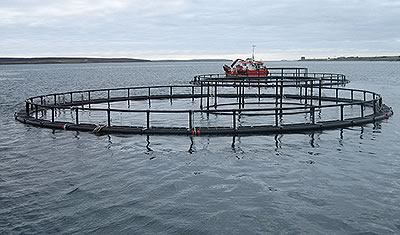 Of the various challenges[1] faced by the Scottish salmon aquaculture industry, the main ones are often seen as escapes and disease, in particular parasitic sea lice and associated pesticide use. The nets are susceptible to damage by adverse weather conditions or predators, and the open mesh design facilitates the influx of parasites and diseases. A variety of solutions are being developed towards mitigating these, with ‘closed containment’ offering obvious advantages for both. While closed containment is traditionally seen as land-based tanks in recirculating aquaculture systems (RAS), innovative designs are being trialled to keep the farming units in the sea. Examples are the ‘Egg’, ‘Marine Donut’ and rebuilt bulkship designs developed by Marine Harvest[2]. These have the advantage of being able to extract sea water from depths at which sea lice are not present as well as containing fish in structures that are not easy to damage.
Of the various challenges[1] faced by the Scottish salmon aquaculture industry, the main ones are often seen as escapes and disease, in particular parasitic sea lice and associated pesticide use. The nets are susceptible to damage by adverse weather conditions or predators, and the open mesh design facilitates the influx of parasites and diseases. A variety of solutions are being developed towards mitigating these, with ‘closed containment’ offering obvious advantages for both. While closed containment is traditionally seen as land-based tanks in recirculating aquaculture systems (RAS), innovative designs are being trialled to keep the farming units in the sea. Examples are the ‘Egg’, ‘Marine Donut’ and rebuilt bulkship designs developed by Marine Harvest[2]. These have the advantage of being able to extract sea water from depths at which sea lice are not present as well as containing fish in structures that are not easy to damage.
The solid sides of closed system structures prevent escapes and protect the enclosed fish from the spread of disease and the ingression of sea lice from wild fish. A land-based structure with RAS has obvious siting flexibility without having to be near a saltwater source. However RAS have a greater carbon footprint than their open net pen equivalent, and at present have significant start-up costs. To date the costs have proved prohibitive to a wide commercial uptake of the technology for on-growing salmon.
Much additional innovation development recently has been in response to the challenge of sea lice. In addition to closed containment, solutions being introduced or trialled are the Thermolicer[3], the use of wrasse and lumpfish as cleaner fish[4], sea lice curtains[5] and deepwater offshore sites[6].
[1] SAMS (2018) Review of the Environmental Impacts of Salmon Farming in Scotland. 196 pp. http://www.parliament.scot/S5_Environment/General%20Documents/20180125_SAMS_Review_of_Environmental_Impact_of_Salmon_Farming_-_Report.pdf
[2] Marine Harvest (2017) Salmon Farming Industry Handbook. 117pp. http://marineharvest.com/globalassets/investors/handbook/salmon-industry-handbook-2017.pdf
[3] https://www.steinsvik.no/en/products/e/seaculture/fish-health/thermolicer/
[4] https://www.fishupdate.com/cleaner-fish-will-change-game/
[5] http://www.bqlive.co.uk/scotland/2018/02/20/news/scottish-sea-farms-boosted-by-anti-sea-lice-shields-30701/?refresh_ce
[6] https://www.fishfarmingexpert.com/news/worlds-first-deep-sea-fish-farm-arrives-in-norway/

